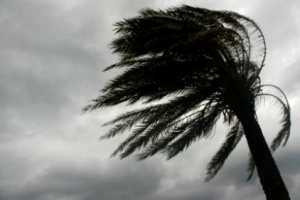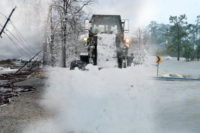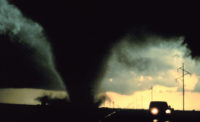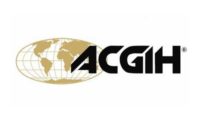 2013 should see a continuation of unpredictable and at times extreme weather conditions. The New York Committee for Occupational Safety and Health, www.nycosh.org, warns that hurricane cleanup and restoration work may have serious risks. Doing the wrong thing can endanger your safety, your health, and possibly your life.
2013 should see a continuation of unpredictable and at times extreme weather conditions. The New York Committee for Occupational Safety and Health, www.nycosh.org, warns that hurricane cleanup and restoration work may have serious risks. Doing the wrong thing can endanger your safety, your health, and possibly your life.
IMMEDIATE SAFETY HAZARDS:
Asphyxiation (death from lack of oxygen) - Do not work in poorly ventilated areas which may be subject to emissions from gasoline-, diesel-, or propane-powered generators, vehicles, or equipment. Carbon monoxide poisoning can occur outdoors as well as indoors.
Building collapse or shift - Do not enter a space that has any sign of not being structurally sound (for example, large cracks in the walls). If in doubt, stay out until it can be professionally evaluated.
Debris piles - Where possible, avoid direct contact with unstable surfaces. Use bucket trucks, stable and secure scaffolding, and/or fall protection with secure anchor points.
Electrocution - Assume that all power lines are energized unless you know they have been deenergized and tested. Do not enter any space that still contains flood waters until you are 100% certain that the electricity is off and will remain off.
Explosion - Do not enter any space where there is a natural gas odor. If possible, do not enter any impacted space until you are sure that gas feeds have been shut off and will remain off.
CHEMICAL HAZARDS:
Toxic particulates (poisonous airborne dusts) - During cleanup or restoration work, you may be exposed to asbestos, lead, silica, cement dust, or other toxic chemicals. Inhaling (breathing in) any of these chemicals can cause serious, permanent, long term harm to your health. Exposure to asbestos or silica may cause cancer. Note: Additional hazards may be present.
To protect against toxic airborne dust, you may need to wear a respirator. A disposable N-95 or greater respirator can provide adequate protection against inhaling silica or cement dust. For protection against asbestos or lead, you will need at least a half face elastomeric (rubberized) respirator equipped with N, R, or P-100 HEPA (high efficiency particulate air) filters.
Do not use paper dust masks - they do not provide significant health protection.
Using a respirator, even the right respirator, probably will not provide proper protection unless you have been fit-tested, trained, and qualified to use a respirator.
If you are an employee and are required to use a respirator, your employer must provide you with a respirator at no cost, along with annual training, fit-testing, and medical clearance.
BIOLOGICAL HAZARDS:
Mold - Water and dampness can cause mold growth on building materials and furnishings, including sheet rock, ceiling tiles, wood, and carpets. Inhaling airborne mold can cause wheezing, respiratory distress, allergic reactions, and severe nasal, eye, and skin irritation.
To protect against breathing in mold, use a disposable N-95 or greater respirator.
Avoid skin contact with chemical or biological hazards. Wear protective gloves and clothing.
FLOOD CLEANUP RESOURCES:
- Centers for Disease Control and Prevention. After a Flood: Precautions when Returning to your Home. http://www.bt.cdc.gov/disasters/floods/after.asp
- Centers for Disease Control and Prevention. Clean Up Safely After a Disaster. http://emergency.cdc.gov/disasters/cleanup
- Centers for Disease Control and Prevention. Natural Disasters: Response, Cleanup & Safety for Workers. http://emergency.cdc.gov/disasters/workers.asp
- Centers for Disease Control and Prevention. Personal Hygiene and Handwashing After a Disaster or Emergency. http://www.bt.cdc.gov/disasters/floods/sanitation.asp
- Centers for Disease Control and Prevention. Reentering Your Flooded Home. http://emergency.cdc.gov/disasters/mold/reenter.asp
- Centers for Disease Control and Prevention. Returning Home After a Disaster: Be Healthy and Safe. http://emergency.cdc.gov/disasters/returnhome.asp
- Environmental Protection Agency. Flooding. http://www.epa.gov/naturalevents/flooding.html
- Environmental Protection Agency. Flood Cleanup and the Air in Your Home. http://www.epa.gov/iaq/flood/flood_booklet_en.pdf.
- http://www.epa.gov/naturalevents/flooding.html
- National Institute for Occupational Safety and Health. Emergency Response Resources: Storm/Flood and Hurricane Response. http://www.cdc.gov/niosh/topics/emres/flood.html
- National Institute for Occupational Safety and Health. Storm, Flood, and Hurricane Response Recommendations for the Cleaning and Remediation of Flood-Contaminated HVAC Systems: A Guide for Building Owners and Managers. http://www.cdc.gov/niosh/topics/emres/Cleaning-Flood-HVAC.html
- National Institute of Environmental Health Sciences. Flood Response Orientation, Safety Awareness for Responders to Floods: Protecting Yourself While Helping Others. http://tools.niehs.gov/wetp/public/hasl_get_blob.cfm?ID=6709.http://www.cdc.gov/niosh/topics/e
- mres/flood.html
- National Institute of Environmental Health Sciences. Protecting Yourself While Removing Post-Disaster Debris from Your Home or Business. http://tools.niehs.gov/wetp/public/hasl_get_blob.cfm?ID=9295
- Occupational Safety and Health Administration. Floods. http://www.osha.gov/dts/weather/flood/index.html
Source: New York Committee for Occupational Safety and Health
www.nycosh.org



